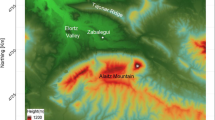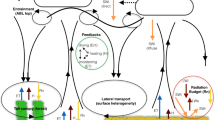Summary
Hourly lysimetric and micrometeorological data taken over a grass surface at the Meteorological Research Unit, Cardington U.K. have been analysed. A temperature difference and measurements of wind speed at only one height, combined with an independently estimated effective roughness length allowed sensible heat and momentum fluxes determination by the profile method on an hourly basis. The estimates are compared with direct measurements of sensible heat and friction velocity obtained by the eddy correlation method. The sensible and latent heat fluxes are also modelled by the resistance method. Equations based on the Monin—Obukhov similarity theory are used to account for stability effects through various forms of parameterization Aerodynamic and surface resistances, necessary for the Penman—Monteith equation are calculated from routinely measured meteorological data. The profile method for estimation of sensible heat flux and friction velocity is found to work excellently on the discussed daytime experimental data which correspond mainly to near neutral or slightly unstable conditions.
Surface latent and sensible heat fluxes can also be described very well by the resistance method. A slightly better estimate of the sensible heat flux is achieved when stability corrections are taken into account. On the contrary Penman-Monteith equation for estimating latent heat flux is insensitive to adjustments for atmospheric stability.
The comparison of the various methods leads to the establishment of empirical relationships which correlate various quantities such as soil heat flux, resistances, evapotranspiration etc. to routinely measured meteorological data.
Similar content being viewed by others
References
Barker, E. M., Baxter, T. L., 1975: A note on the computation of atmospheric surface layer fluxes for use in numerical modeling.J. Appl. Meteor. 14, 620–622.
Blackwell, M. J., 1963: The role of evaporation in the surface energy balance. The water relations of plants. Blackwell scientific publications, 19–36.
Beljaars, A. C. M., Schotanus P., Nieuwstadt F. T. M., 1983: Surface layer similarity under nonuniform fetch conditions.J. Climate Appl. Meteor. 22, 1800–1810.
Berkowicz, R., Prahm L. P., 1982: Evaluation of the profile method for estimation of surface fluxes of momentum and heat.Atmos. Environ. 16, 2809–2819.
Berkowicz, R., Prahm, L. P., 1982: Sensible heat flux estimated from routine meteorological data by the resistance Method.J. Appl. Meteor. 21, 1845–1864.
Brutsaert, W., 1975: Comments on Surface roughness parameters and the height of dense vegetation.J. Meteor. Soc. Japan,53, 96–97.
Burridge, D. M., Gadd, A. J., 1977: The Meteorological Office operational 10-level weather prediction Model. Sci. Pap. No. 34, Meteor. Office, London.
Businger, J. A., Wyngaard, J. C., Izumi, Y., Bradley, E. F., 1971: Flux-profile relationships in the atmospheric surface layer.J. Atmos. Sci. 28, 181–189.
Campbell, D. I., 1989: Energy balance and transpiration from Tussock grassland in new Zealand.Bound.-Layer Meteor. 46, 133–152.
De Bruin, H. A. R., 1983: A model for the Priestley-Taylor parameterα.J. Climate Appl. Meteor. 22, 572–578.
De Bruin, H. A. R., Holtslag, A. A. M., 1982: A simple parameterization of the surface fluxes of sensible and latent heat during daytime compared with the Penman—Monteith concept.J. Appl. Meteor. 21, 1610–1621.
Deheer-Ammissah, A., Hogstrom, U., Smedman-Hogstrom, A. S., 1981: Calculation of sensible and latent heat fluxes and surface resistance from profile data.Bound.-Layer Meteor. 20, 35–49.
Dyer, A. J., Hicks, B. B., 1970: Flux-gradient relationships in the constant flux layer.Quart. J. Roy. Meteor. Soc. 96, 715–721.
Dyer, A. J., Bradley, E. F., 1982: An alternative analysis of flux-gradient relationships at the 1976 ITCE.Bound.-Layer Meteor. 22, 3–19.
Högström, U., 1974: A field study of the turbulent fluxes of heat, water vapour and momentum at a “typical” agricultural site.Quart. J. Roy. Meteor. Soc. 100, 624–639.
Holtslag, A. A. M., de Bruin, H. A. R., Van Ulden, A. P., 1980: Estimation of the sensible heat flux from standard meteorological data for stability calculations during daytime. Proc. of the 11th Internat. Tech. Meet. on Air Pollution Modelling and its Applications, Amsterdamm Plenum, 401–407.
Monin, A. S., Obukhov, A. M., 1954: Dimensionless characteristics of turbulence in the atmospheric surface layer.Dokl. Akad. Nauk SSSR 93, 223–226.
Monteith, J. L., 1965: Evaporation and environment. The state and movement of water in living organisms, 19th Symposium, Soc. Exp. Biol., 205–235.
Monteith, J. L., 1975:Principles of Environmental Physics revised edition. London: Arnold, 241 pp.
Paulson, C. A., 1970: The mathematical representation of wind and temperature profiles in the unstable atmospheric surface layer.J. Appl. Meteor. 9, 857–861.
Richards, C. J., 1979: Micrometeorological characteristics of the 1976 hot spells.Meteor. Magazine, 108, 1979.
Smith, F. B., Blackall, R. M. 1979: The application of best experiment data to the parameterization of the dispersion of plumes from ground level and elevated sources. Mathem. Modelling of Turbulent Diffusion in the Environment, Harris, J. (ed.). London: Academic Press, 201–235.
Stewart, J. E., Thom, A. S., 1973: Energy budgets in pine forest.Quart. J. Roy Meteor. Soc. 99, 154–170.
Stricker, H., Brutsaert W., 1978: Actual evapotranspiration over a summer period in the “Hupsel Catchment”.J. Hydrol. 39, 139–157.
Swinbank, W. C., 1955: An experimental study of eddy transport in the lower atmosphere. Tech. Pap. No. 2, Melbourne CSIRO Div. Meteor. Phys.
Thom, A. S., 1972: Momentum, mass and heat exchange of vegetation,Quart. J. Roy. Meteor. Soc. 98, 124–134.
Thom, A. S., Oliver, H. R., 1977: On Penman's equation for estimating regional evaporation.Quart. J. Roy. Meteor. Soc. 103, 345–358.
Van Zyl, W. H., De Jager, J. M., 1987: Accuracy of the Penman-Monteith equation adjusted for atmospheric stability.Agric. Forest Meteor. 41, 57–64.
Verma, S. B., Rosenberg, N. J., Blad, B. L., Baradas, M. W., 1976: Resistance-energy balance method for predicting evapotranspiration: determination of boundary layer resistance and evaluation of error effects.Agron. J. 68, 776–782.
Author information
Authors and Affiliations
Additional information
With 8 Figures
Rights and permissions
About this article
Cite this article
Jacovides, C., Kerkides, P., Papaioannou, G. et al. Evaluation of the profile and the resistance method for estimation of surface fluxes of momentum, sensible and latent heat. Theor Appl Climatol 45, 145–154 (1992). https://doi.org/10.1007/BF00866403
Received:
Revised:
Issue Date:
DOI: https://doi.org/10.1007/BF00866403




